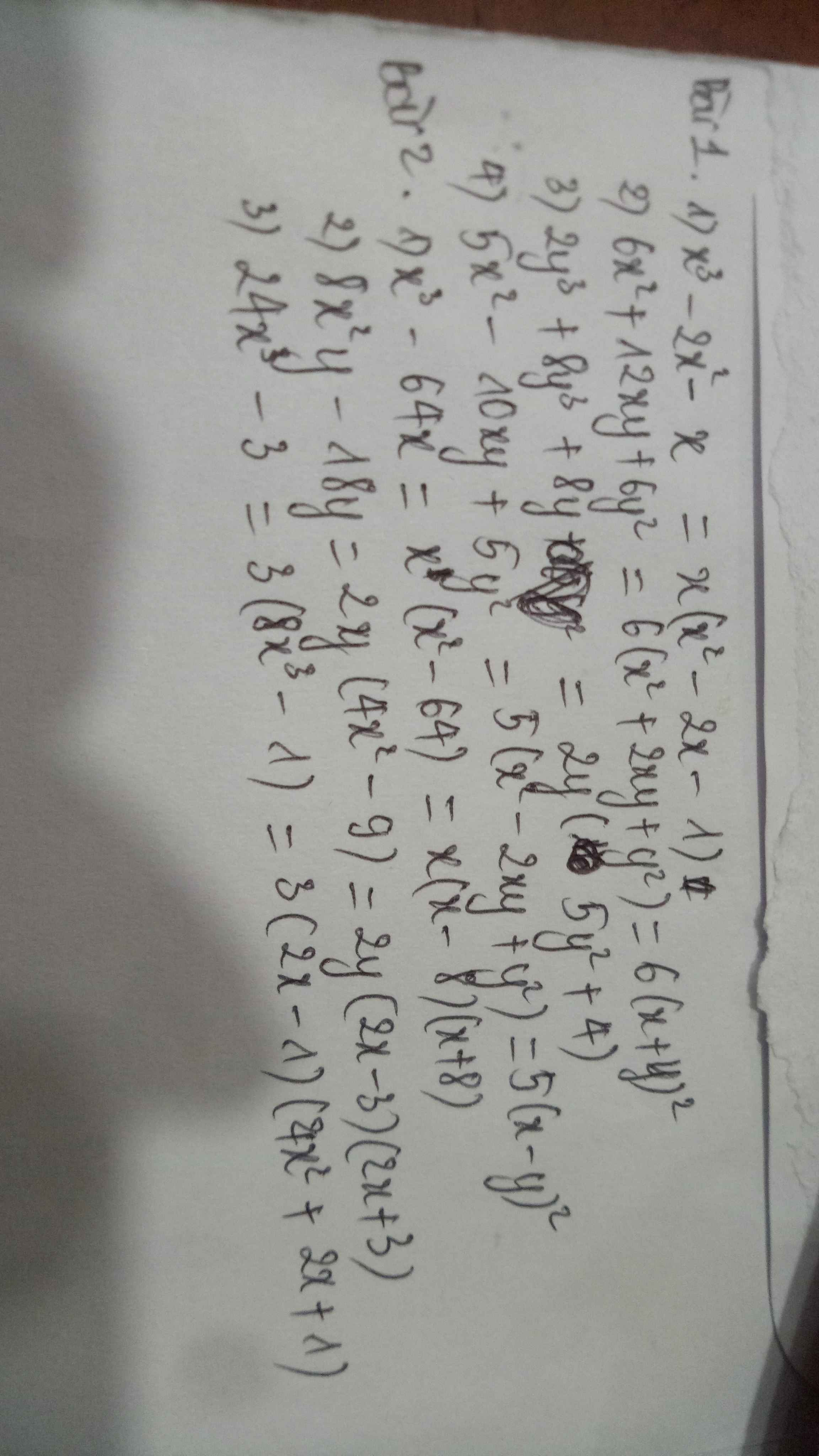
Hãy nhập câu hỏi của bạn vào đây, nếu là tài khoản VIP, bạn sẽ được ưu tiên trả lời.


x 4 - 5 x 2 + 4 = x 4 - 4 x 2 - x 2 + 4 = x 4 - 4 x 2 - x 2 - 4 = x 2 x 2 - 4 - x 2 - 4 = x 2 - 4 x 2 - 1 = x + 2 x - 2 x + 1 x - 1

*Đoán nghiệm sử dụng tính chất của đa thức:
Ta dễ dàng nhận thấy đa thức \(P\left(x\right)=x^3+4x^2-19x+24\) không có nghiệm là \(\pm1\).
Giả sử \(P\left(x\right)\) có nghiệm hữu tỉ dạng \(\dfrac{p}{q}\left(p,q\inℤ\right)\), không mất tổng quát giả sử \(q>0\). Khi đó \(p|24\), \(q|1\) \(\Rightarrow q=1\).
Khi đó do \(P\left(x\right)\) không có nghiệm là \(\pm1\) nên \(p\in\left\{\pm2,\pm3,\pm4;\pm6;\pm8;\pm12;\pm24\right\}\)
Thử lại, ta thấy không có số \(p\) nào thỏa mãn \(\dfrac{p}{q}\) là nghiệm của P(x). Vậy đa thức \(P\left(x\right)\) không có nghiệm hữu tỉ \(\Rightarrow\) \(P\left(x\right)\) không thể phân tích thành nhân tử.
* Chú ý rằng chỉ khi \(degP\left(x\right)\le3\) hoặc \(degP\left(x\right)⋮̸2\) thì từ P(x) không có nghiệm hữu tỉ mới suy ra được P(x) không phân tích được thành nhân tử nhé. Nếu \(\left\{{}\begin{matrix}degP\left(x\right)\ge4\\degP\left(x\right)⋮2\end{matrix}\right.\) thì chưa chắc điều này đã đúng. VD: Đa thức \(Q\left(x\right)=x^4+4\) không có nghiệm hữu tỉ (nó thậm chí còn không có nghiệm thực) nhưng ta vẫn có thể phân tích thành nhân tử như sau:
\(Q\left(x\right)=x^4+4=x^4+4x^2+4-4x^2\)
\(=\left(x^2+2\right)^2-\left(2x\right)^2\)
\(=\left(x^2-2x+2\right)\left(x^2+2x+2\right)\)

45 + x 3 - 5 x 2 - 9 x = x 3 - 5 x 2 - 9 x - 45 = x 2 x - 5 - 9 x - 5 = x - 5 x 2 - 9 = x - 5 x - 3 x + 3

Bài 1:
\(1,Sửa:x^3-2x^2+x=x\left(x^2-2x+1\right)=x\left(x-1\right)^2\\ 2,=6\left(x^2+2xy+y^2\right)=6\left(x+y\right)^2\\ 3,=2y\left(y^2+4y+4\right)=2y\left(y+2\right)^2\\ 4,=5\left(x^2-2xy+y^2\right)=5\left(x-y\right)^2\)
Bài 2:
\(1,=x\left(x^2-64\right)=x\left(x-8\right)\left(x+8\right)\\ 2,=2y\left(4x^2-9\right)=2y\left(2x-3\right)\left(2x+3\right)\\ 3,=3\left(x^3-1\right)=3\left(x-1\right)\left(x^2+x+1\right)\)
Bài 3:
\(a,=5\left(x^2+2x+1-y^2\right)=5\left[\left(x+1\right)^2-y^2\right]=5\left(x-y+1\right)\left(x+y+1\right)\\ b,=3x\left(x^2-2x+1-4y^2\right)=3x\left[\left(x-1\right)^2-4y^2\right]\\ =3x\left(x-2y-1\right)\left(x+2y-1\right)\\ c,=ab\left(a-b\right)\left(a+b\right)+\left(a+b\right)^2\\ =\left(a+b\right)\left(a^2b-ab^2+a+b\right)\\ d,=2x\left(x^2-y^2-4x+4\right)=2x\left[\left(x-2\right)^2-y^2\right]\\ =2x\left(x-y-2\right)\left(x+y-2\right)\)

\(5x^2-19x-4=5x^2-20x+x-4\)
\(=\left(5x^2-20x\right)+\left(x-4\right)\)
\(=5x\left(x-4\right)+\left(x-4\right)\)
\(=\left(5x-1\right)\left(x-4\right)\)
= 5x^2 + x - 20x - 4
= (5x^2 + x) - (20x + 4)
= x(5x+1) - 4 (5x + 1)
= (5x+1) (x - 4)

5x2 (x – 2y)– 15x(x – 2y) = x.5x(x - 2y) - 3.5x(x - 2y)
= (x - 3).5x(x - 2y)

\(\text{x^3 – 5x^2 + 8x – 4 }\)
\(\text{= x^3 – 4x^2 + 4x – x^2 + 4x – 4}\)
\(\text{= x( x^2 – 4x + 4 ) – ( x^2 – 4x + 4 )}\)
\(\text{= ( x – 1 ) ( x – 2 )^2}\)
\(x^3-5x^2+8x-4=x^3-x^2-4x^2+4x-4\\ =x^2\left(x-1\right)-4x\left(x-1\right)+4\left(x-1\right)\\ =\left(x^2-4x+4\right)\left(x-1\right)\\ =\left(x-2\right)^2\left(x-1\right)\)

Ta có : \(x^4-5x^2+4\)
\(=x^4-x^2-4x^2+4\)
\(=x^2\left(x^2-1\right)-4\left(x^2-1\right)\)
\(=\left(x^2-1\right)\left(x^2-4\right)\)
\(=\left(x-1\right)\left(x+1\right)\left(x-2\right)\left(x+2\right)\)
Ta có: \(x^4-5x^2+4\)
\(=x^4-x^2-4x^2+4\)
\(=x^2\left(x^2-1\right)-4\left(x^2-1\right)\)
\(=\left(x^2-1\right)\left(x^2-4\right)\)
\(=\left(x-1\right)\left(x+1\right)\left(x-2\right)\left(x+2\right)\)

\(5x^2-19x-4\)
\(=\left(5x^2-20x\right)+\left(x-4\right)\)
\(=5x\left(x-4\right)+\left(x-4\right)\)
\(=\left(x-4\right)\left(5x+1\right)\)
\(5x^2-19x-4=5x^2+x-20x-4\)
\(=x\cdot\left(5x+1\right)-4\cdot\left(5x+1\right)\)
\(=\left(5x+1\right)\cdot\left(x-4\right)\)